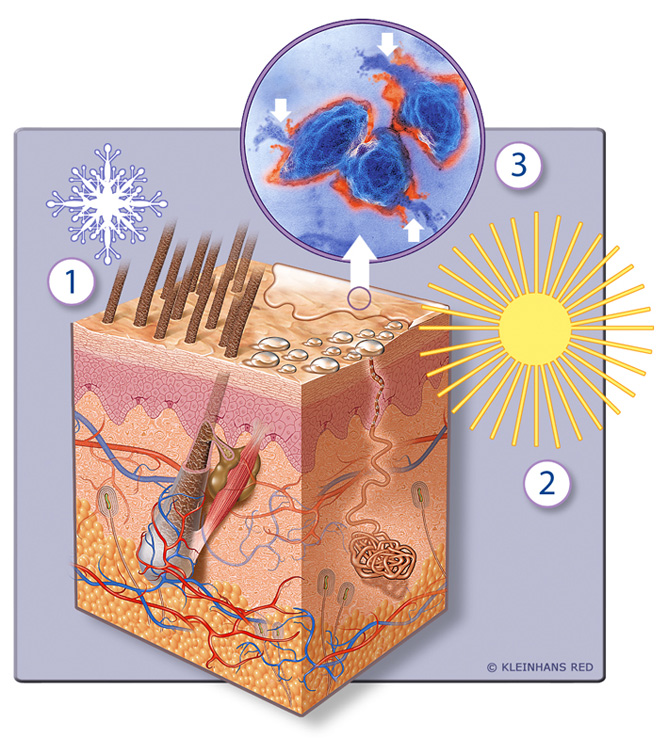The protective functions of the skin
The skin is the largest human organ. Its major task is to serve as a barrier to the outside world and to protect the body from influences from the environment. It further protects the body from drying out overheating and does not allow undesired germs to penetrate into it. The skin is closely connected with the psyche. It receives touch stimuli through the sense organ and reacts on pressure and temperature.
In our schematic representation of the skin, the major skin functions are shown. Primarily, the skin is built up as a protective organ and has a metabolism of its own. The skin is very sensitive to environmental influences, different temperatures, cold, (see diagram (1)) and solar irradiation (2), which leads to sweat formation (sweat area with bacteria metabolism products (3)).
Our cross-section of the skin shows four skin compartments and penetration routes. The outer layer is the epidermis with keratinocytes and horny cells which represent the surface. Below, the basal membrane is found between the dermis and epidermis, which is connected with the dermis through collagen structures. Under the basal membrane, the dermis, nerve endings, lymph vessels and capillaries of the blood vessel system are located. The hypodermis is the interior skin layer under the hair papillaries and consists of connective and adipose tissues. Temperature regulation is its main task.
Thus, another major function of the skin is temperature regulation. Through widening or narrowing of the blood vessels in the skin and by secretion of liquids over the skin's glands, the skin has an influence on the body temperature.
The skin has a barrier function. The pH-value of intact skin is 5.5. This is due to endogenous acid substances in sweat, sebaceous and horny cells. The significance of this acid property of the skin's surface becomes obvious by the so-called "acid protection layer".
This acid protection layer or hydro lipidic film plays a major role in the skin's protection next to the keratinized cell layer of the epidermis. It is formed by secreted sebum and sweat glands and the lipids of the horny layer and lies directly on the horny layer (stratum corneum), the outer visible part of the epidermis. It has antimicrobial effects and protects the skin from alkaline and acid substances. If the acid protection layer is intact, it keeps the bacterial decomposition of sweat components low.
The horny layer protects the skin from penetrating substances and mechanical influences thus preventing the organism from losing water and electrolytes. The openings which are formed by appendages such as hair, sebaceous and sweat glands are further penetration routes.
Among the further major tasks of the skin is its function as a sense organ and its function to communicate with the environment. By means of a series of receptors such as warmth and cold receptors or intraepithelial nervous endings, which, in total, turn the skin into a sense organ, stimuli such as cold, warmth and pain are perceived.
Further sense organs are Vater-Pacini corpuscules (pressure and tension sensors)), Meissner's touch corpuscules or touch discs (receptors for touch), corpuscules of Ruffini (receptors for expansion) and Krause end bulbs (mechanoreceptors).
Through blushing, paling and other expressions which are regulated by the autonomic nervous fibres, the skin functions as a sense organ and communication system, which is closely connected with the autonomic nervous system.
Finally, the skin has an immune function, in that it has a major significance in immunobiological defense processes.
References
- Helmut Leonhardt, Histologie, Zytologie und Mikroanatomie des Menschen, Vol. 3, Thieme, Stuttgart 1990
- Peter T. Pugliese, Physiology of the Skin II, Allured Publishing Corporation

